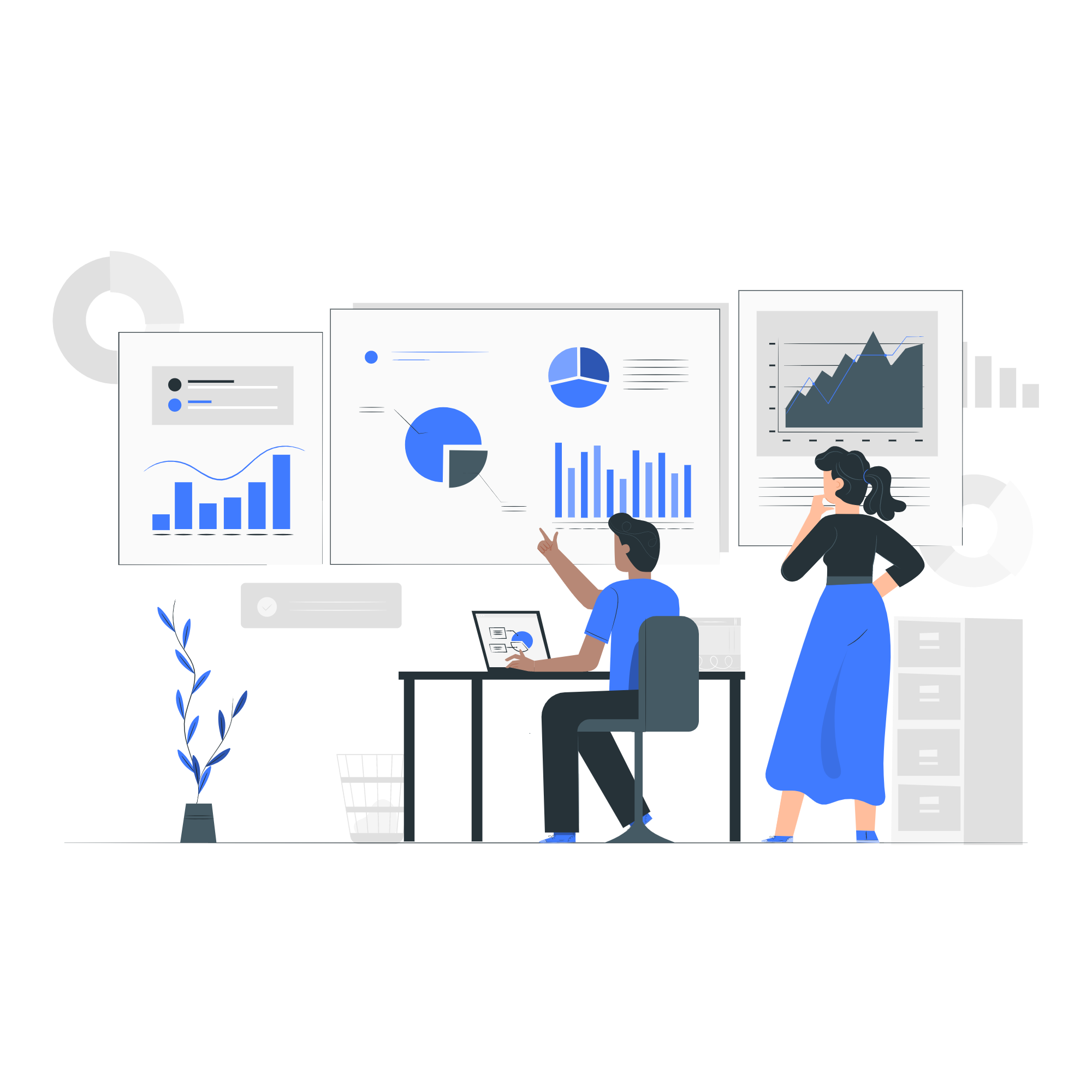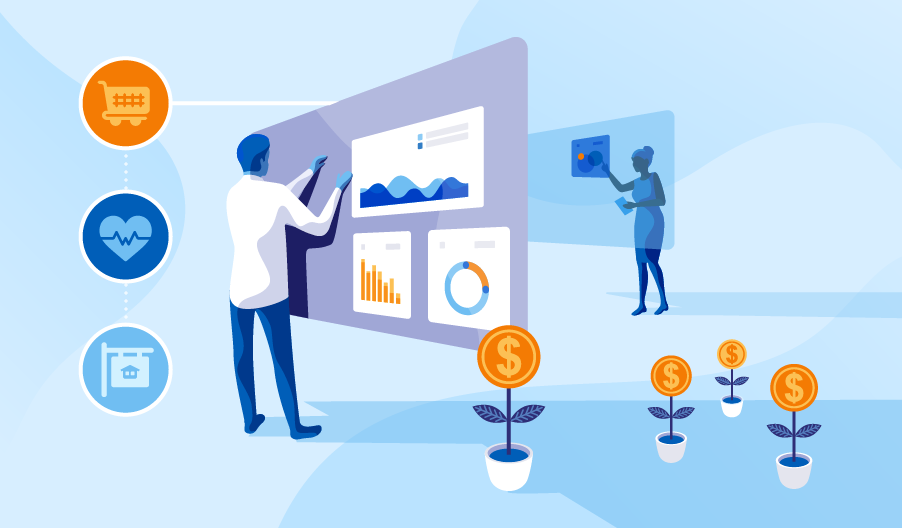What is marketing analytics?
Marketing analytics studies data from marketing campaigns to discern patterns such as how a campaign contributed to conversions, consumer behaviors, regional preferences, creative preferences, etc. It involves measuring the marketing activities of a business by utilizing technologies and software that collect marketing data, aggregate it, and offer visualizations that help them figure out which tactics are working and the best way to optimize their marketing expenditures.
The marketing analytics world uses mathematics, predictive modeling, and machine learning to reveal insights from data about consumers. The folks involved in measuring the marketing activities of a business utilize technologies and software that collect marketing data, aggregate it, and offer visualizations that help them figure out which tactics are working and the best way to optimize their marketing expenditures.
Modern analytics tools allow stakeholders to analyze data as it comes in quickly, so marketing can adjust, if needed, based on changing trends. They also enable companies to use predictive analytics to predict these trends instead of reacting to them.
It identifies all the tools and platforms that any team uses and will consolidate the data they produce for analysis. While the software may be doing much of the legwork, how teams work with data and derive insights from it makes marketing analytics successful.

What are some types of marketing analytics data?
There is a variety of marketing analytics data that can be collected, categorized, and analyzed, including:
✅ Campaign performance data (such as estimated results, Click Through Rate [CTR], etc.);
✅ Customer behavior data (such as website visits, leads generated, conversion rates, etc.) across channels and devices;
✅ Digital media consumption/sharing patterns;
✅ Social media engagement metrics (such as shares or likes on posts or tweets).
How to get around with Marketing Analytics?
Enterprises should integrate their data before analytics because data analysis across different marketing channels may uncover new, unexpected insights. With insights about customers and an ability to monitor return-on-investment for marketing efforts, marketing analytics provides the ability to build data-driven strategies for the organization. The insights gained through marketing analytics can allow organizations to enhance customer experiences, increase return on investment (ROI) from marketing efforts, and craft future marketing strategies.
Every marketing team member may employ some form of data analytics in their marketing. With marketing data analytics, marketers can look beyond Web metrics to track business metrics such as leads, sales, and ROI. By collecting data from all the marketing channels into a single, consolidated data platform or environment, marketing analytics allows one to measure and analyze all key metrics in one place.
A robust marketing analytics plan will identify all the tools and platforms a team uses and consolidate the data they produce for analysis. If some can do this effectively, analytics tools can significantly boost marketing efforts. While one could probably apply analytics to traditional offline marketing, digital marketing makes tracking marketing data significantly easier and uses analytics tools to distill that data. Tracking analytics for an active campaign helps marketers discover key insights about customer behavior, trends, and essential data for sales teams.

What are the challenges in marketing analytics and how to overcome them?
The main challenges in marketing analytics are understanding what data is best to use for analysis, making sure the data is available in a usable format, and being able to interpret the results. Organizations can overcome these challenges by using various analytical methods and tools, having effective data governance processes in place; and regularly reviewing their findings.
Various analytical methods and tools can help overcome these challenges, including data visualization, causal analysis, predictive modeling, and segmentation.
Data visualization can help users understand the data quickly and easily, while causal analysis can help identify relationships between variables.
Predictive modeling is used to predict what will happen in the future based on past events. At the same time, segmentation helps identify customers who are more likely to respond positively to specific campaigns or products.
Data governance processes can help ensure that data is accurate and available in a format that can be used for analysis. These processes should include determining who has access to the data, providing the data is updated as needed, monitoring trends and patterns in the data, and taking action based on analytics findings.
These techniques allow organizations to understand their customers better and how they interact with their products/services.
What are the best practices in marketing analytics?
Effective marketing analytics includes using trackable data sources (such as click-through rates and conversion rates) to measure campaign success, tracking customer behavior across channels and devices, and using automated analytical tools to help identify trends and patterns in customer data.
Additionally, it’s essential to keep an eye on the business’s overall digital marketing strategy—including paid and organic campaigns, website design/optimization, viral content creation/distribution, etc.—to ensure that all channels work together synergistically towards a common goal.
Organizations must ensure that marketing analytics data is accessible and actionable. Users can ensure that the campaign information is shared and used effectively across the organization by designating a lead analyst or other personnel responsible for receiving, analyzing, and interpreting marketing data.

What are the areas of business application?
There are a variety of business applications for marketing analytics, including:
✅ Measuring customer engagement (such as frequency and duration of visits, pages viewed, etc.) to understand their behavior and preferences;
✅ Detecting potential areas of growth or decline within the customer base;
✅ Determining whether specific marketing campaigns are helping/hindering sales goals;
✅ Assessing how different changes to the website or other marketing materials may affect lead acquisition and conversion rates;
✅ Making decisions based on comparative data gathered from past campaigns.
Companies will collect more effective data analytics when teams are aligned with company goals, informed about strategy, responsive to organizational structures, and exposed to customers. Marketers can bolster their approach to predictive analytics by giving their data science teams access to all data, including semi-structured and unstructured data, and ensuring that they have robust data governance policies addressing how sensitive customer data can be.
To achieve insight, data analysts need to take physical time away from data analytics, possibly visiting customers to get them up to speed on the market’s needs. Also, attend marketing planning meetings to understand company goals better and help ensure data (IT), data analytics, and marketing are all aligned.
How Marketing Analytics Can Empower Marketers
Marketers rely on marketing analytics to measure performance and identify areas where they need to improve. By understanding customer demographics, psychographics, and behavioral patterns, marketers are better equipped to understand their target market and create compelling messaging that resonates with them. In addition, marketing analytics can help marketers track the effectiveness of their advertising campaigns and quantify the impact of various promotional activities such as offers or discounts. Marketers must do the following:
Optimizing the email campaign to increase open rates and click-through rates (CTRs)
Use clearly-written subject lines that intrigue recipients, avoid overcomplicating or misleading subjects, as this will only confuse readers and hinder their participation in the poll, and keep the titles short and sweet, so they’re easy for people to scan without losing too much information about the content of the email.
Keeping the emails interesting by including catchy images, videos, or other interactive elements that encourage recipients to click through from beginning to end is key.
Using Targeted Advertising
To improve Monitor Campaign Performance, Targeted Advertising can be used to connect with customers most likely to convert. This would allow for targeted messaging and offers that resonate more with those most likely to take action.
Connecting with customers that are most likely to convert; Monitoring Campaign Performance to pinpoint where best improvement can be made.

Using A/B Testing to test different variants of the email campaigns and ads.
A/B testing works by randomly assigning one of two different variants to a group of recipients. Marketers can then track how these recipients perform in terms of opens, clicks, and conversions. This information can help them determine which variant is most successful for the campaign or ad.
Evaluating the Results Regularly
Comparing the results against similar businesses or industries to get an idea of where one could improve. One can also use customer feedback and surveys to better understand what the customers want from them. And finally, they must keep an eye on the trends in the industry to stay ahead of the competition.
Using marketing analytics, users can identify communication channels to most effectively reach their customers and adjust their messaging accordingly. By constantly improving strategies, users can ensure that they remain competitive in an ever-changing marketplace.
A Guide to business intelligence
What is Business Intelligence?
Business intelligence (BI) encompasses various activities, technologies, and practices that allow business managers to manage data effectively. BI provides actionable insights into the performance of an organization by delivering helpful information in a form that executives can easily access.
It includes reporting, monitoring, forecasting tools, and analytics capabilities that enable organizations to make informed decisions about their operations. Business intelligence is not a one-size-fits-all approach. Instead, it depends on the needs of the organization and the type of data you are trying to collect.
For example, business analysts might use different tools and techniques when working with transactional versus analytical data. BI is used to manage operational data or customer information.

The Evolution of Business Intelligence
Business intelligence and analytics have been evolving for years now. They started as tools that could help managers make better decisions about their businesses, but they’ve since grown into powerful platforms that can automate various business tasks.
Business intelligence and analytics are now essential parts of any organization’s data compilation process, helping to uncover insights that can be used to improve performance. Businesses have relied on various tools to compile and analyze data.
This process has been time-consuming and often results in inaccurate analyses. Business intelligence and analytics offer a more streamlined way of gathering data, analyzing it, and making informed decisions. They can automate tasks that used to be done by individual managers or employees, saving time and improving efficiency.
Business intelligence and analytics tools can provide insights into areas that may not have been previously investigated. Businesses can create a more comprehensive picture of their operations by using these platforms to gather information from various sources.
Business Intelligence Applications in the Enterprise
A vital business intelligence application in any enterprise is a data warehouse.
Data warehousing provides the organization with an all-encompassing view of its current and past business data. They allow senior decision-makers to glean critical insights from large amounts of data quickly and easily. This can help optimize operations, identify opportunities, and make smarter decisions that impact the bottom line. A well-functioning data warehouse helps reduce information duplication across departments, streamline reporting processes, and improve overall organizational efficiency.
Collaboration between different departments within an organization is crucial. This way, everyone in the company can gather relevant information from various sources to make better decisions faster.
Customization: A BI tool should be easy to use and allow one to customize it to fit their specific needs. A customized tool is essential to provide the best possible experience for the user. A mechanism should be designed specifically for each user’s needs, which means it can be tailored to their specific workflow and preferences. This makes it easier for users to find what they’re looking for and reduces the time needed to search for information or complete tasks.
Critical areas of functionalities in business intelligence and analytics include finance, operations, marketing and sales, human resources, and accounting.
The Functions of Business Intelligence
Functions that can be addressed with business intelligence and analytics include financial analysis, operations research, sales forecasting, customer management, human resources management, and organization track.
In addition to providing analytical insights into these critical areas of business operations, BI can create dashboards or reports that provide quick access to critical data for decision-makers. Some of the standard BI tools and platforms include:
✅ SAP Business Objects
✅ BI Platform
✅ Microsoft Excel
✅ Google Sheets

Business intelligence best practices
Use of dataflow
Dataflow is a software development process and an umbrella term for several related data management methodologies. It includes the concepts of pipelines, workflows, data flows, and state machines.
Pipelines are an intermediate result of dataflow processing where artifacts (data items) are combined or processed as part of a single step in the workflow. Workflows represent a series of interconnected pipelines that result in the generation or consumption of business output.
A pipeline might be used to process customer orders from receipt to shipping; order fulfillment from the warehouse to an e-commerce site.
A centralized repository for all BI data.
A centralized repository for all BI data is essential to create a cohesive and consistent view of all business intelligence datasets. This will enable analysts to rapidly identify trends and correlations across disparate datasets, making it easier to track progress and make informed decisions.
It can help reduce the time wasted on repetitive data searches, saving valuable resources in terms of time and money.
Constant testing and tweaking of dataflows
By automating processes and integrating disparate data sources, one can ensure that their BI solutions are consistent and accurate—essential factors if they want to make informed decisions quickly.
Continuous monitoring
One must regularly review and update monitoring dashboards and reports to reflect current trends and changes in data sources. This will help ensure that they are always aware of any issues or deviations from normal behavior that may warrant further investigation.
One must implement automated alerts and notification capabilities for significant changes or anomalies in data.
Data Mining
Data mining is one of the essential tools available to business intelligence professionals because it helps them extract information from large amounts of unstructured or semi-structured data. Data mining involves analyzing large amounts of data to find patterns and relationships.
Data Warehousing
A data warehouse contains all of a company’s data so that it can be accessed quickly, stored securely, and updated easily. The industrial methods include reporting, analyzing, predicting, structuring, and active warehousing for easy data management.
Business Intelligence Applications (BIA)
Business intelligence applications (BIA) is an umbrella term that describes various technologies that provide users with real-time access to relevant metrics, reports, and dashboards on their computers or mobile devices. These tools provide insights into how well an organization performs by providing valuable information such as key performance indicators (KPI), scorecards, and trends at any given time during a business day.

BI Trends: Machine Learning (ML), Artificial Intelligence(AI), and the Internet of Things(IoT)
Machine Learning (ML) is an emerging technology that can be used to improve the efficiency and effectiveness of data analysis. The ability to process large amounts of data from multiple sources, such as social media and other online sources, means that ML can help businesses make more informed decisions about their products and services.
Data streaming and learning is one application of artificial intelligence and the internet of things in business intelligence. Data streaming refers to automatically collecting, processing, analyzing, and sharing data as it happens, rather than waiting for a scheduled, time-consuming process, such as compiling survey results. This allows organizations to react quickly to changes in their environment, improving decision-making. For example, if there is a change in sales patterns, businesses can analyze what caused the change and take appropriate action sooner rather than later.
Another application of data streaming and learning is in the area of customer service. Customer service organizations can use machine learning algorithms to understand how customers interact with their products or services. This allows them to improve the quality of customer service by understanding what works best for each customer and making adjustments as needed.
The limitations of business intelligence
Getting a complete picture of an organization’s finances and operations can be challenging from data gathered through BI tools. As BI systems become increasingly sophisticated, they may require more specialized knowledge to use them effectively.
There is always the risk that organizations will rely more than they should on BI tools rather than on their judgment and intuition when making decisions. BI tools are only as good as the data they are based on. If this is not up to scratch, then information gleaned from BI tools may be inaccurate or incomplete.
They can’t replace the critical thinking required by any organization, even if they provide you with some helpful information. Business analytics is not enough; an organization must be able to think critically about the data it’s getting from its BI systems and how best to use that data in conjunction with other sources of information.

How Social Listening Helps in Business Intelligence
Social listening can help with business intelligence by helping an organization understand what its customers are saying about its brand. As a result, they will be able to find ways to improve their experience with it and with the product or service they’re purchasing. The organization will also learn which of its competitors’ services or products are performing better than its own, so it can focus on improving those areas and come out on top.
Social media is an excellent place for businesses to get real-time customer feedback. Using tools like Facebook Live and Instagram Stories, businesses can create a constant stream of content that allows them to interact with their customers in real-time. This will enable them to respond quickly when something goes wrong, or they need some advice from someone who knows how they work best. By listening carefully, businesses can create a positive customer experience.
BI systems must first understand the company’s business processes and requirements. This business context requires careful attention to detail during the design phase. Once this is established, data can be analyzed to produce reports that help users make better decisions.
Once organizations have identified both the problems and solutions involved in building their BI system, it’s time to begin working through some basic planning steps, such as:
✅ Determining the scope of their project (i.e., how many users will be accessing this system)
✅ Identifying who within the organization should be involved in designing this solution (and who should be responsible for implementing it once it’s complete)
✅ Deciding how much time each participant should spend on their tasks to study market dynamics.
✅ Creating security wireframes for the BI system. If ignored, it creates a potential security risk; an attacker could access sensitive data sources or sensitive employee accounts, and they could potentially cause significant damage to the organization’s reputation or financial health.

